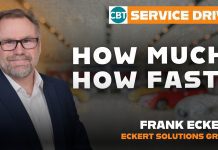Recently, the National Automobile Dealers Association launched a new initiative called the Voluntary Protection Products: A Model Dealership Policy. This policy aims to proactively help NADA members maintain a process to sell voluntary protection products that is compliant with federal regulations. To find out more about the policy, we caught up with Charlie Gilchrist, NADA Chairman and Paul Metrey, NADA Legal and Regulatory Affairs Vice President.
Don’t forget to register for the 2020 NADA Show here
Jim: Hello, everyone. Thank you so much for joining us on another edition of CBT News. I’m Jim Fitzpatrick. And I’m so happy to be joined today by Charlie Gilchrist, who is the NADA Chairman, and also Paul Metrey, who is the NADA Legal and Regulatory Affairs VP. Gentlemen, welcome into CBT news.
Charlie G.: Thank you. It’s great being here.
Jim: Sure. So let’s dive right in here. You’ve got a program that you’re launching, Voluntary Protection Products Model Dealership Policy. Boy, that’s a mouthful. Charlie, can you tell me a little bit about that and what it’s designed to do?
Charlie G.: Well, voluntary protection products are a very important part of our business and these products provide a valuable benefit to our customers that protects their investments. So if we offer them and sell them and administer them in a very transparent and compliant way, it gives our customers a valuable benefit. It protects their investment in cars and frankly, offers them peace of mind. So for all of our dealers, we’ve set up an optional template, which they can install in their dealerships and that enables them to have processes in place to offer these products. And it also helps comply with our federal and state laws. So these are very important products for our customers. Something that they want. And we wanted to make sure that we offer them and sell them and administer them in a very transparent and customer-friendly way.
Jim: Okay. And you’re speaking about the products that we sell in our F&I offices today, right?
Charlie G.: So these products are like extended service contracts, GAP waiver, maintenance policies. There’s tire programs, there’s window programs, windshield programs, and … So these are very important products for our customers.
Jim: Okay. Great. And Paul, how does this initiative all come together?
Paul M.: Well, there have been concerns expressed by consumer advocacy groups. There have been some legislative proposals at the state level. There’s been some critiques that have been present in the press. There have been some attacks against the process, against the products themselves, and it’s something we want to get out in front of. Anytime there’s a concern expressed about some aspect of the dealer’s business, we want to assist our members with a tool that can assist them in responding to that and to do the type of things Charlie just talked about. And that really is what prompted the creation of this.
Paul M.: And I will say, in it together, we had the benefit of multiple inputs. We were able to really get excellent input from professionals throughout the entire industry, certainly the dealership level, dealer attorneys, audience sources, VPP providers, former regulators, many others to try to really develop the optional tool that could help dealers respond to the type of concerns that have been expressed.
Jim: Okay. And, Paul, we know that the entire Dealer-Assisted Financing Model was once in the crosshairs of the CFPB. Is this VPP initiative forward-leaning or are you responding to the regulatory concerns?
Paul M.: I think there’s aspects of both. Certainly, there are regulatory concerns we want to respond to, but we also want to be forward-leaning. We want to make sure that before there’s some big movement to try to really alter how these valuable products can be offered to consumers, we have something in place that assist our members. And in particular, oftentimes, when consumer advocacy groups are trying to attack something, they’re trying to demonstrate that the ordinary competition are not protecting consumers. So they think government can just step in and fill the void and they want to demonstrate a market failure.
Paul M.: By putting out a product that addresses their concerns, we take away that narrative. We demonstrate then there’s not a market failure. Competition does [inaudible 00:00:04:26]. Transparency and being comfortable with the process certainly facilitates good purchasing decisions. And that is something that we think will assist us both in terms of demonstrating compliance but also avoiding attempts or successful attempts at further regulation.
Jim: Okay. Charlie, how have dealers responded to having this model policy out there for their use?
Charlie G.: Well, we’re rolling this out and, frankly, there’s some dealers that don’t know anything about it yet. So we’re trying to get the word out. But the dealers that I’ve talked to that are implementing it seem to be embracing it. I know we’ve done that at our stores. It’s worked out very well. But we just need to get the word out so all the dealers can take a look at it and, frankly, figure out how they can implement it, because so many times they think it’s very difficult, but it’s really not that difficult of a process.
Jim: Okay. And, Paul, how have finance sources that underwrite these types of policies responded?
Paul M.: It’s really been universally positive, which has been very encouraging. We’ve had a chance engage AEA, the Consumer Bankers Association, certainly a number of credit unions in a variety of forums. Every time we talk about it, it’s warmly received. In fact, several of them have communicated to their dealer clients that they view this as a very valuable resource, something dealers should talk to their attorneys about, and they’ve provided it to them. So that really has been something that’s been very strong, very positive. And I would also add that voluntary protection product providers and their trade associations as well have been very supportive. And of course, they also offered some excellent input into the development of the product.
Jim: Okay. Charlie, where are you in the implementation process at your dealerships and what was it like getting things up and running in your F&I office?
Charlie G.: We’ve implemented it in all of our stores. The process is not that difficult. It’s sounds mind-boggling when you first talk about it, because basically what you’re going to do is you’re going to price all of your products. So you’re going to have a suggested retail price and that sounds like that’s very difficult to do, but the reality of it is it’s really not. We price them every day. So we set up a suggested retail price for all of our products, and then, if you deviate from that price, you deviate down. So you document why you’re deviating down. And it’s for legitimate business purposes, so it’s really not that difficult to establish.
Charlie G.: So our F&I, I really believe that it makes you a better dealer. It makes your F&I or business majors more comfortable with the process because they’ve got [inaudible] term and pricing. And I think it makes it easier for them and it’s really a professionally documented and processing way. And so it makes it easier to do business and our customers love it.
Jim: Yeah. Talk to us about that. What’s the feedback been so far from your customers and…
Charlie G.: The customers like the transparency. They like being able to see it. And they feel at ease. The whole point of this is to do a business and document it in a very transparent and compliant way. And they see that and it puts them at ease. It puts our F&I or business majors at ease. So I think it’s a win-win for everyone.
Jim: And is that safe to say that those same sentiments are with your F&I managers? They’re aboard too?
Charlie G.: I ask all the time because we’re kind of leaders in this and I want to make sure that we’re continuing on this process. The training, the compliance training, all that makes you a professional. And I really believe it makes our F&I or our business managers still a lot more comfortable with the process. And I know being transparent to the customers makes them feel just wonderful.
Jim: Yeah, for sure. It’s somewhat like when we introduced the menus into F&I offices and people were a little bit nervous at first saying, “Man, you’re going to give the customer all of these different options.” And what happened, we saw the F&I back-end gross profit go up when the customers were given all of those choices right up front and put them in the driver’s seat. This is a program that’s similar to that, right?
Charlie G.: One of the things that dealers ask me all the time, “Do your penetration levels go down? Does it affect your business?” And the reality of it is it doesn’t. In fact, in some of our stores, it has actually gone up because of it. So I think every dealer ought to take a look at it. Again, this is an optional template for them. But the template is really, really well put together and this is a very easy process if dealers would just take a good serious look at.
Jim: Yeah. And coming from you, you’ve got a number of stores, so you’ve got real-world experience in this area. I mean, you’re touting this as it’s working. This is a good program.
Charlie G.: It is working. We installed it in our biggest store in January and we continually monitor it. But I will tell you the reviews our customers give us, our F&I or our business managers as we talk to them, it is all good. And again, it makes them feel a little bit more comfortable. They have pretty established retail pricing. And it is a good process and it just makes it better. They’re better people.
Jim: Yeah, for sure. So, Paul, what’s the next step in the process here?
Paul M.: Well, as Charlie indicated, the program or the policy was just released in April, so it’s quite young. We’re trying to get the word out. At every opportunity, we’re talking to our members about it. We did send a copy to every member back in April. We’ve sent it also to the State and Metro Dealer Associations. Charlie at every opportunity speaks about it to different groups. Certainly, those of us here at NADA Headquarters Building are doing the same every time we visit with a group. We want to get the word out and make sure people are aware of this tool and continue to demonstrate out the benefit.
Jim: Sure. So it sounds like an exciting program, one that every dealer needs to learn more about. Charlie Gilchrist and Paul Metrey with the NADA. I want to thank you so much for joining us on CBT today and sharing these ideas in this program with our viewers. It’s been very enlightening.
Charlie G.: Thank you very much. It’s our pleasure.
Jim: Great. Thanks so much.









